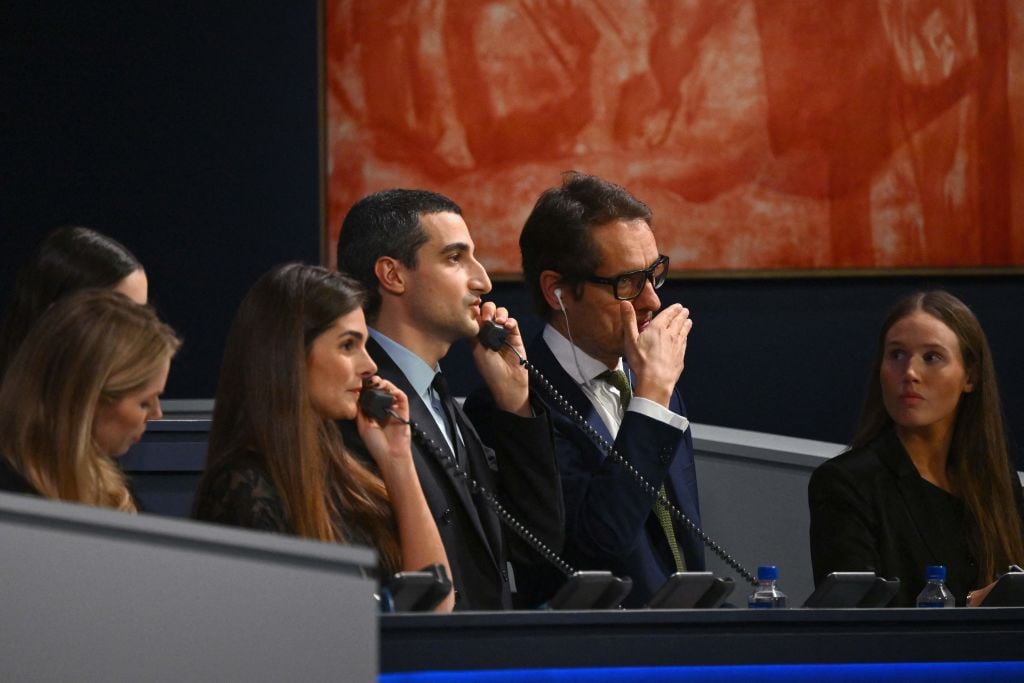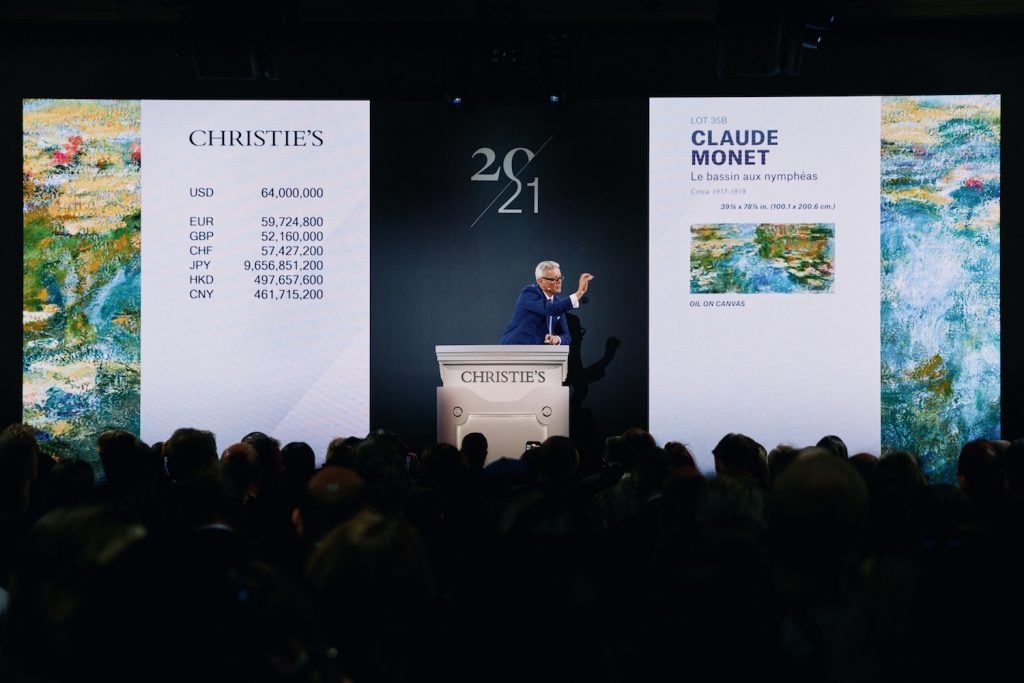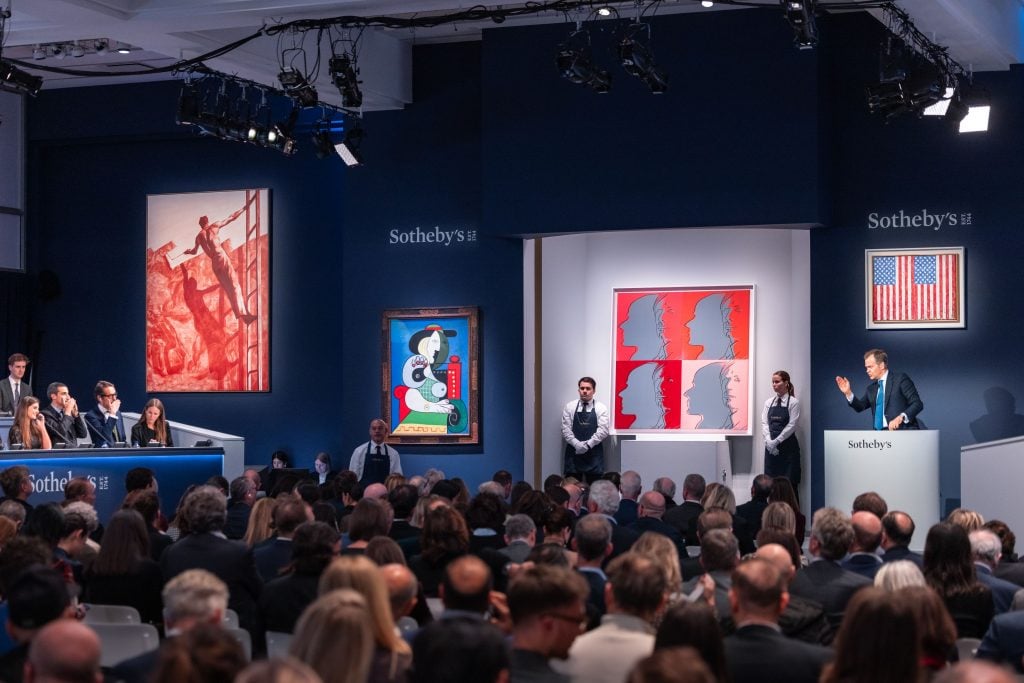The Hammer
Simon de Pury on How the Auction Houses Took the Thrill Out of Their Own Game
The veteran auctioneer weighs in on the double-edged sword that is the financial guarantee.

The veteran auctioneer weighs in on the double-edged sword that is the financial guarantee.

Simon de Pury

Every month in The Hammer, art-industry veteran Simon de Pury lifts the curtain on his life as the ultimate art-world insider, his brushes with celebrity, and his invaluable insight into the inner workings of the art market.
With an increasingly volatile global situation and an uncertain economic climate there were quite a few question marks, going into the New York November sales at Sotheby’s, Christie’s and New York, as to how the art market would be affected by it all. The results were surprisingly robust and have already been expertly commented on in the columns of Artnet News. As Katya Kazakina indicated, the totals for the sold works at the three houses for the equivalent auctions were $2.2 billion this year versus $3.2 billion in 2022 and $2.3 billion in 2021. This points out that the readjustment of the market is modest at best. 2022 was exceptional because it included the Paul Allen Collection, the private collection that reached the highest sales total ever.
As opposed to most businesses that sell material goods, the auction houses don’t manufacture any of the goods they sell and are entirely dependent on the four D’s (Death, Debt, Divorce and Discretionary Selling) to provide a pipeline of works of art to be sold. They never know more than three to six months ahead of time what they will be selling. They have heavy fixed costs that need to be covered no matter what the flow of incoming business looks like. The only advantage that the two leading companies have is that they form a duopoly. This means that images of the majority of works being potentially sold at auction land on the desks or iPhones of Christie’s and Sotheby’s executives. They have to make sure that they win slightly more often than they lose. What they lose automatically goes to their main competitor. At the latest when you leave the employ of one of these firms you realize that you have to make a hundred times the effort to get a hundredth of the result.
Collectors will buy wherever they find what they are looking for or what gives them a coup de foudre. There is little or no client loyalty in that direction. In the old days loyalty used to be a—if not the—deciding factor in the choice of the auction firm that you would sell through. Most collectors have such a deep emotional bond to the artworks they have acquired over the years that selling can be heartbreaking. Asking an auction house expert to handle their sale is like entrusting your own children to your friends. Loyalty is usually personal and linked to an individual at one of the firms, as opposed to being abstract and linked to a company as a whole.

Jussi Pylkkänen selling the top lot of Christie’s 20th Century evening sale, Monet’s, Le bassin aux nymphéas for $74 million.
An intense courtship of key collectors was as important for the top executives of the main auctioneers as for the directors of top museums. Way back in my days as chief auctioneer at Sotheby’s I remember visiting a distinguished collector in her apartment on New York’s Fifth Avenue. As I sat opposite her on a beautiful but not very comfortable Louis XV armchair, she told me: “Yesterday J. Carter Brown (then director of the National Gallery in Washington D.C) sat in the chair where you are sitting, the day before Christopher Burge (then chief auctioneer at Christie’s) sat there, and three days ago it was Philippe de Montebello (then director of the Metropolitan Museum of Art).”
It also meant that after a while in the business your clients became your closest friends. In some cases they could even become your lovers or spouses. In my days, there was a story circulating that the single daughter of a mega collector who had recently passed away summoned executives from both Sotheby’s and Christie’s to her house to present her with a sales proposal. She fixed an appointment for 5 p.m. on a given day with a member of one firm and for 10 a.m. the next day with the representative of the other. When that person rang the doorbell at 10 a.m. he had the most unpleasant surprise to have the door opened not by the collector’s daughter but by his direct competitor from the other firm dressed in a bathrobe and greeting him with the words “Sorry mate, it’s too late!” As the Italians say ‘se non è vero e ben trovato’— even if it is not true, it is a very good fabrication.
The one person who changed the whole auction game drastically was A. Alfred Taubman who bought Sotheby’s in 1983. He had invented the modern shopping mall concept and was a shrewd businessman. It is he who introduced the practice of offering financial guarantees to the owners of major potential consignments. Christie’s while initially grumbling against this innovation very rapidly had to follow suit in order to remain competitive. The risk element was off the table for consignors but they were giving up a part of the upside in return. Guarantees rapidly became the main weapon to secure coveted single owner collections or outstanding individual paintings.

The room at Sotheby’s evening auction of the collection of Emily Fisher Landau. Courtesy of Sotheby’s.
Initially, guarantees seemed to be wonder weapons which made high profile auctions more profitable for the auction firms. After a while the competition between the houses became so fierce that winning a top consignment could turn out to be a Pyrrhic victory as the auction itself could be financially loss making for the victor. The practice of giving guarantees blossomed well into the aughts until the sale cycle of October/November 2008 in London and New York brought about significant losses for the main auction firms. Luckily the slowdown of the market was short lived, as opposed to what happened after June 1990 when Japanese buying stopped from one minute to another. From 2009 onwards the auction companies became more prudent in the handing out of guarantees. They had been burnt and gotten away with a black eye.
It is at this moment that they started arranging third party guarantees. Prior to being chosen by the vendors of a given work they would identify a collector whom they considered a prime contender for it and ask him or her to put up a guarantee or irrevocable bid. This created a win-win situation for the third party guarantors. Either the works they coveted would end up in their collection at a discount, or else they wouldn’t get the work but they would have the consolation price of a sometimes hefty upside. For the gentleman or lady who conducts the auction, gavel in hand, as well as for the public, it takes out most of the suspense. The issue is no longer if something will sell, but rather if the work will go to the third party guarantor or to another collector. If there is zero interest on a lot prior to the sale, it is withdrawn. This means that the percentages of works sold are either in the upper 90’ies or even better “white glove sales” i.e. 100 percent sold. The auctioneer can concentrate on the show aspect of the proceedings and some auctions can appear nearly like charades. The irony is that it is now mostly the preselling to the third party guarantors that determine the success of the main auction weeks. In a way, the auction houses are the main dealers under the guise of being auctioneers.
The big edge the leading top five to eight galleries have over the auction houses is that they have rosters of the most important living artists. They just need to encourage their artists and provide them with optimal working conditions but don’t have to anguish over where their next consignments will come from. They can delegate this anguish to the artists having to create.
Simon de Pury is the founder of de PURY, former chairman and chief auctioneer of Phillips de Pury & Company, former Europe chairman and chief auctioneer of Sotheby’s, and former curator of the Thyssen-Bornemisza Collection. He is an auctioneer, curator, private dealer, art advisor, photographer, and DJ. Instagram: @simondepury